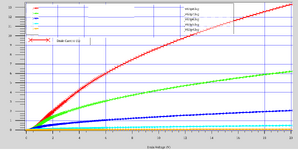GLR
Newbie level 4

Hi guys... is it realistic the following simulates Rdson(iD) for a High Voltage SiC mosfet belonging to high-Ron class?
Is acceptable for you a similar Rdson(iD) of a commercial SiC mosfet?
What is your opinion?
[Ohm] vs [A]

Is acceptable for you a similar Rdson(iD) of a commercial SiC mosfet?
What is your opinion?
[Ohm] vs [A]
Last edited:


